 Good day ! My name is Christian Berndt, and with this page I would like to help you further to set up your own solar system.
Good day ! My name is Christian Berndt, and with this page I would like to help you further to set up your own solar system.
It’s a lot easier than you think. Here I have summarized everything for your DIY do-it-yourself solar system.
It is all based on my own experience – and what I learned along the way.
First things first: Yes, it’s very worth it. Yes, even today, even without receiving funding. And it’s easy to do.
Why is it worth it?
You save money.
Really. Even if there’s a lot of talk out there.
It is ecologically correct.
It is structurally correct if the electricity is produced on site.
It is politically correct.
My personal project
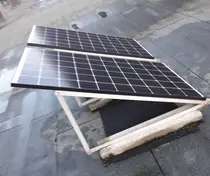
Your own project may look different – but here’s mine: I’m putting a small system on my flat roof. This will cover 20% of my electricity consumption.
You will immediately ask why I decided it exactly the same way, so the answers to that above:
- Why only cover 20% of electricity consumption?
For my individual circumstances, I have calculated that it has the greatest economic effect. I will have got the cost of my system in after three years – and then start saving money.
If I wanted to cover more than 20% of my consumption, this shifts the cost-effectiveness considerably: then the costs were amortized much later.
For example: if I wanted to cover 70% of my electricity consumption, the money would only be saved after 15 years.
- Why only a small system?
Because it’s simple. Little technology, no maintenance, simple setup, little can break, no batteries, no battery charging technology. And to do well for me alone: ??put it down, connect it, done – without complicating it.
- Why do it yourself?
This selvPV system does not need any technical skills, is itself feasible without significant craftsman costs.
If you need a roofer for a pitched roof or want to decide on a large system, then it looks a little different.
Cover the basic electricity load with your solar system
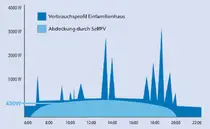
With a solar system you cover a large part of the base load. This is not only economically interesting. But you also help that the large base load power plants such as lignite have to work less hard: this has a significant ecological leverage.
What about the feed-in tariff?
Does not make sense for a small system, has also been made politically deliberately unattractive. But if you only generate 20% of your own electricity requirements, then you use all of this electricity yourself. The idea of wanting to put something into the power grid is economically pointless.
How big must my system be?
The unit for solar systems is „Wp“. For example, my system here has a size of 620 Wp and consists of only two solar modules.
This „620 Wp“ is the power rating of solar collectors – the more the more power.
So your question is: how much Wp should my solar system have?
You can get a first, quick assessment of how expensive it will be: look at your electricity bill to see your annual electricity consumption in kw / h.
1000 kw / h is 250-300 Wp
2000 kw / h is 300-400 Wp
3000 kw / h is 400-600 Wp
4000 kw / h is 700-900 Wp
5000 kw / h is 900-1000 Wp
With this list you can quickly estimate how fat the system must be.
With this knowledge of how much WP your system should have, look now for providers who offer SelfPV systems. I bought from Greenakku.de There was a packaging error and I had initially received one panel too little. I am still very satisfied because the problem was solved very quickly, easily and very friendly.
Estimate the profitability of your solar system more precisely
The list above is actually enough. Only if you have the ambition to want to calculate it more precisely: there are computing systems on the Internet with which you can calculate more precisely in order to estimate the size of your solar system. I was happy with https://stromrechner.ibc-solar.de/
There you can enter roof angles, south orientation and many other of your individual parameters – to program such a thing and to make it available to the public via the Internet: a great thing. I would like to give the provider applause.
My tip: do not stick to the exact size of your roof area, but simply click on the amount of two, three or four solar panels to test them out.
Make a list:
1 module are X Wp and bring XX Euro savings
2 modules are X Wp and save XX Euros
3 modules are X Wp and save XX Euros
and so on …
You will see that there is a „crack“ in the results in which the profitability shifts. This is the break-even point you are looking for.
- Possibility Number 1:
In the event that you – like me – choose a small system, you should stay at or below this point. In order to spend as little money as possible and get into profitability as quickly as possible. In my individual case, I cover 20% of my electricity consumption and have the costs out after only three years. - Possibility 2:
In the event that – unlike me – you decide to have a larger system, you will see that the costs increase because you also need storage systems. Electricity consultants like to calculate that at the age of 15 the profitability limit is reached, so that the money doesn’t start until the 16th year.
If you are thinking about this variant, I would rather recommend you to think about a few other things. How do you rate your future life? How old are they ? How old are you when the money starts saving? Can it be that your children will be out of the house at some point – and will your electricity requirements change as a result? What is the probability that one day you will move? Maybe because of work, health or love? Decide for yourself: does it make sense to make an investment for a period of time that you cannot be sure of?
My recommendation for you: resurrect the temptation to build the largest possible system. Set up the point „after X years, the money will start to save“ so that you can be sure of this advantage yourself.
- Option 3:
They strive for full care. Want to generate 100% of your electricity yourself. And don’t get anything from the electricity suppliers.
My recommendation: forget it. It is incredibly expensive. Reaching the economic limit is almost impossible.
This train of thought only makes sense if you live so remote that you have no power supply.
Or alternatively, that you find livestyle restrictions acceptable. You should find restrictions in order: „either the washing machine is running or I am ironing – we do not have the electricity for both at the same time.“ „The washing machine only runs when it is day. Because only then will the solar collectors supply electricity.“ „Of course we cook with gas, because an electric stove uses too much electricity“
Achieving full self-sufficiency is a fat thing. But if you are interested, do the math: on the website it is possible with just a few clicks.
What about flat roofs?
Be sure to remember that not every flat roof is accessible and can withstand the weight of a person. It would be stupid if the roof breaks open below you and you fall through the hole.
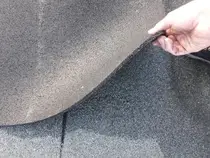
Usually you need „building protection mats“ which you put under the stand of the system to protect the roofing felt.
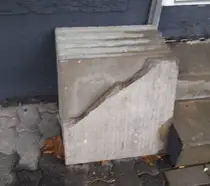
These are available for small money in the hardware store where you could also think of weights so that the system does not lift off in the event of a storm and causes damage. Maybe you will find step plates from the garden area, which you put on the legs of the stands to weigh them down?
What about pointed roof?
You can also conveniently order the installation material that you need for your type of roof from the providers with the solar system. Slate roof, Bieberschwanz or tiled roof – you need special assembly material for everything.
And maybe you need the expertise of a real roofer. Depending on the situation at your site, it may also be necessary to set up a scaffold. As occupational safety – so that roofers can work without endangering their lives.
So that can be quite expensive. And maybe kill the economics of the plant. Isn’t it perhaps possible for you on flat ground?
Do I need an electrician?
For a large system: yes, definitely. Without skills and expertise, you have no chance.
In a small system like the one I set up, it is extremely simple electrically, so some dare to do it without an electrician. But treat yourself to a call to the electrician anyway: if you have done a good job, it will be done quickly and will not write a big bill if you work short hours.
Even if the connection of the small system is simple: you should strictly comply with the VDE guidelines when wiring – if only for your fire protection.
If you – dear reader – do not know what VDE guidelines are, then with all your enthusiasm for do-it-yourself you may not have the knowledge to be really on the safe side. Treat yourself to a real electrician. If you have good preparatory work, this only has to do quick work.
The power cord
In the case of complete systems, there is „what you need“ – but the power cable is not. In the hardware store you can buy what you need individually.
Resist the temptation to buy the cheapest: the poor thing has to endure extreme heat in summer, bitter frost in winter and wet weather when it rains. For at least the next 30 years.
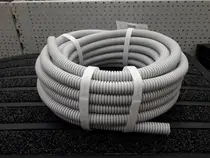
As far as it „lies around“ on the roof, slide it into a protective tube.
And see that it doesn’t come to rest in the puddles that usually form on a roof. That is not super bad – nothing happens at first. However, you should still try to avoid it. A spacer between the cable and the roof surface would be awesome.
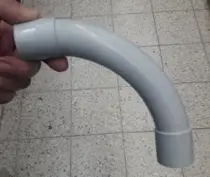
Somewhere it is so far and the cable goes down from the roof area over the edge. The wind will always cause a little movement on it, cold and heat expansion will also occur. Protect the poor cable by inserting it into a rigid tube – at least where the cable can bend (viewed for a long time).
Do not tie the cable to the lightning rod. In the case of a direct hit, that might be very, very bad.
And it would be really awesome, you would manage that the cable does not become a trip hazard. Walking around on a roof is known to be dangerous. So stumbling there is not a good thing.
Where to connect the power cord?
It is not necessary to connect the cable to the fuse box. It is sufficient to have a connection to your own electricity network somewhere in the house.

It is therefore sufficient to bring the three wires of the system together with the three wires of a power line. Sounds easy, but you should at least switch off the power line completely. Simply switching off a fuse is not enough here.
When wiring, make sure that the ground wire is properly grounded. You could also check this. Your electrician has measuring devices for this.

Under no circumstances should you wire a conventional plug for a normal socket: there would be a risk.
 If it is absolutely necessary to have a socket, there are also very special sockets with which it is safe. I found the „Wieland feed socket“.
If it is absolutely necessary to have a socket, there are also very special sockets with which it is safe. I found the „Wieland feed socket“.
Which electricity meter is good?
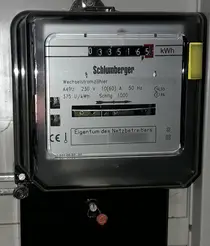
Does your electricity meter have a dial? It’s good.
And look that the symbol of a backstop is missing:
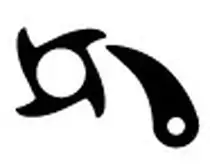
Rotary wheel is there, backstop missing? Then it’s alright ! You can continue very relaxed, the following explanations are only of importance to you to the extent that you are definitely interested in an even load distribution in your building’s electricity network.
But if there is a backstop symbol: that is bad luck. If you generate more electricity than you consume yourself, this electricity runs into the public power grid for free. The electricity meter does not turn backwards. You are giving away your electricity.
With a small system like mine, with which I only produce 20% of my requirements, I basically always use all of the electricity myself. The fact that the electricity meter turns backwards has no real economic significance.
But if the rotary wheel is missing, then it is not a three-phase meter. It’s probably digital. At least to some degree, your electricity meter is not balancing. If he does not work on a balancing basis, it is really bad: to a certain extent you will not be able to use the electricity you have generated yourself. A non-balancing electricity meter is hard for you to bear.
Only if the rotary wheel is missing, please find out whether your electricity meter is not working in a balancing manner. Allegedly, all electricity meters in Germany are balancing. In fact, there are serious doubts that it is really true. Therefore, ask 1. directly from the manufacturer and 2. research on the Internet. And 3. pray that the claims are really true.
And: take a particularly good look at the following section with the current phases, because in this case you should definitely select the optimal current phase.
Which phase of the current should the power cable be connected to?
This section is particularly important when the electricity meter is not balancing. Otherwise you may be interested in a healthy distribution of the electricity load in the building.
A house connection usually consists of a power cable, also called „heavy current“ or „three-phase current“. This contains the three current phases.
Allow me to simplify something with the current phases, because it is not really complicated: please imagine that not one power cable comes into the building but three cables. Each of the three cables has electricity separately.
As an an example:
The first cable supplies the kitchen and living room with electricity.
The second cable supplies the bedroom and basement.
The third cable supplies the garden, washing machine and dryer.
To which of the three cables (… to which current phase …) should you now connect your solar system?
Is your electricity meter balancing?
Then it does not matter. Your electricity meter calculates the consumption so that it is billed fairly. What makes connecting your small system easy: You can adapt to the random circumstances. Where does a power cable go into the house now? Maybe something like a garden outlet? If possible, you can also connect your PV system there, which saves drilling in walls – and everything is good.
Is your electricity meter not balancing?
This is very, very bad because you are losing money. Parts of your electricity flow into the power grid and you sometimes don’t have the opportunity to use your own electricity.
In this case, all you have to do is hang your solar system on the best possible phase – where you consume the most continuous power. But where is the best phase?
Which power phase do I connect my solar system to?
The example again:
The first cable supplies the kitchen and living room with electricity.
The second cable supplies the bedroom and basement.
The third cable supplies the garden, washing machine and dryer.
In the example above, the thickest consumers in a household – i.e. the dryer and the washing machine – would be connected to the third cable. But because the dryer does not run all day long, it is not the best idea to connect the solar system there.
In the example, phase 1 would be the best decision. Not because the electric stove in the kitchen is the largest consumer of electricity. But because refrigerators and the standby of the entertainment electronics result in permanent consumption.
It is really easy to find out with some research which electricity consumers are connected to which phase.
Step 1: disconnect sensitive devices such as TVs, computers and game computers from the mains – to protect them from damage.
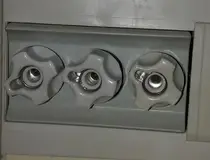
Step 2: You will find three main fuses in the electrical box – one for each of the three current phases. It is often white fuses that can be turned. Unscrew the first one and see where the electricity stops.
Step 3: You could, for example, simply check with a handy bedside lamp whether there is still electricity on a socket or not.
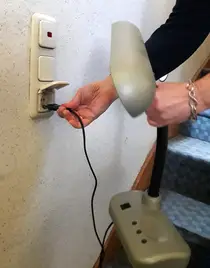
Make a list of where the power is gone after you have removed the first fuse. You now know what depends on phase 1.
Then remove the second fuse and look where the current is now gone. You now know what depends on phase 2.
When the third fuse (phase 3) is removed, everything should really be de-energized. If not, you should be very surprised and wonder where the remaining electricity comes from.
Step 4: Now you start to ponder where most of the permanent consumers are. This is the optimal phase for connecting your solar power system.
Measure success
Do you want to know how your PV system works and enjoy the result?
The providers often offer you additional modules that you can buy for an astonishing amount of money. Some require a connection to your WLAN, transfer the data to a server where you can then query them with your smartphone.
My recommendation: think about how urgently it really is. There is no real benefit you get from it – except maybe your own vanity. Above all, these additional things make it more complicated and have the potential to hack a security hole into your internet.
What do you want to do when you realize that little electricity is being generated? Or if you generate a lot of electricity? I think you won’t be able to change anything anyway. This is why this information is of no use to you.
If you tinker with passion: I have seen a Raspi project which monitored the solar system using a Fritzbox power switch socket. The creative joy of a hobbyist can also be a nice benefit: the link is here.
The feeling of wellbeing in your stomach that electricity is now being generated can also be obtained differently: with my inverter, for example, there is an LED which flashes green when electricity is being generated. The more it flashes, the more electricity is being generated at this very moment.
A cup of coffee tastes better when I can see the blinking on the inverter. A little vanity.
Lightning rod
There are mounting options for earthing on the frame of the solar panel. How far you are obliged to connect them to the lightning arrester or grounding cable I cannot answer. However, I very often don’t see it connected and cannot imagine dangerous short circuits in the panel itself.
(Just for the sake of completeness: the important inverter is properly grounded.)
I cannot give you any advice at this point.
If the roof had a lightning rod, I would connect it there. Not to protect the solar system – this will probably be defective after a direct hit – but to protect the house as a whole.
Wind protection
Remember that a solar panel is large enough to take off like a sail during a storm. You definitely have to weigh down the stand – or screw it tight. And think about storm protection: could it make sense to tie what?
Hail protection
I have no solution what a hail protection could look like. Do you have a suggestion for me?
Permits are needed
I do not know whether you need permits for small systems or have to register something. You may also be interested in staying as quiet and quiet as possible – not that anyone else comes up with the idea of installing a disadvantageous electricity meter.
What about VAT, electricity tax, electricity levy?
Yes, you have to pay sales tax – also known as VAT – for the electricity you generate yourself. And as I understand it, electricity tax and electricity levy. How should you calculate this if you cannot determine the electricity yield? I do not know it either.
If politicians really wanted the energy transition, they would write a tax exemption in the laws for self-operated small plants. This would make it clean and manageable. Other nations have done that.
Give electricity to others?
Do you want to sell the electricity you generate to others – for example to people in your neighborhood? Then you have to measure everything, settle the accounts, register a trade, pay taxes and levies … better not do that to yourself. It will be big cinema – for little electricity.
How long does the solar system live?
As far as I know, the guarantees of the solar modules go up to 25 years. Without having calculated it, I therefore assume that the CO2 footprint of a plant is very good. And maybe there will be opportunities for valuable silicon recycling in 25 years.
Alignment of the modules
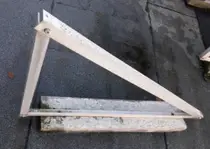
It would be great if the sun always fell on the modules at right angles. That would be an angle in Germany of 36 degrees, depending on the latitude in northern Germany, and 30 degrees in southern Germany. I can not explain why there are so many elevations of 25 degrees to buy.
Ideally considered to be south. In the event that you can’t do it with your pointed roof, I can comfort you: the exact angle is not so important.
Shading has a much greater impact to the detriment of your electricity yield.
Self-cleaning of the modules
Dirt significantly reduces performance.
The more inclined the modules are, the more they clean themselves: the rain tends to wash away dirt.
So if you are lucky enough to be able to choose it: put the place where shading and dirt are less likely.
Does an anti-reflective coating make sense on the collectors?
Yes, a special surface on the glass surface of the collector increases the efficiency considerably. Because most losses result from reflection: the light is chased away by reflection.
But does that have to be? Isn’t it cheaper to put up a module more than to bear the additional costs of a special surface? Very simple: see which price is acceptable for you. And how much „Wp“ collector power you get for it …
The inverter
Direct current comes from your solar system, but your sockets want alternating current. In order for this to work, the small system sets always include suitable inverters, which let the current pulse in time with your power connection.
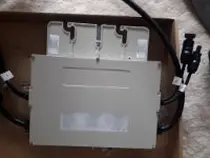
An inverter is a gray box with electronics that has to go somewhere near your collectors. Amazingly difficult. Although it is weatherproof, you should still store it in the shade of the solar panels, protected from too much sun and rain. Then the electronics feel better for longer and stay healthy.
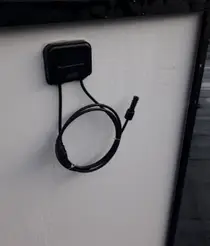
The wiring is ultimately simple. The connection is pre-assembled on the PV panel and easy to plug into the inverter.
The operating instructions for my device recommend: Never disconnect the solar module from the inverter while it is still connected to the power grid.
Will the solar system help me if there is a power failure?
No. As nice as it would be in the event of a power failure to be able to produce some electricity yourself: it doesn’t work. The inverters of your solar system absolutely need the alternating voltage cycle on your power connection in order to be able to cycle the direct current into alternating current.
So: in the event of a power failure, the inverter cannot inverter – and does not let any electricity through. Unfortunately, it is of no use as an emergency system. If you had a customized solution, I would be happy to hear from you.
If you operate your system with batteries for temporary storage, you could discuss this question with your installing electrician. Maybe it will look different there.
Made in china
Yes, basically all solar systems come from China. There is only one small factory in Germany. You can rightly accuse the federal government of deliberately destroying the solar industry.
Since the Chinese government has a significantly higher degree of foresight, solar production has been optimized there. That’s why everything comes from China today.
Power grids
From the point of view of us citizens, it makes sense to relieve the electricity grids and generate electricity on site where it is also used.
If e-mobility really increases, it is questionable whether our electricity grids are otherwise sufficient.
Against nuclear power
You can buy green electricity anywhere in Germany today. In some places – for example towards Bavaria – the power lines do not exist sufficiently. In such cases, something incredibly perverse happens.
You conclude a supply contract with an eco-electricity provider such as Lichtblick. This generates the electricity and fills it somewhere in the power grid. But because there is no suitable power line to you, this electricity is thrown away by the network operators. And in your area, a nuclear power plant will produce the electricity you get.
Yes it is. It may well be that you pay for green electricity – and you throw this electricity away to produce your electricity in a nuclear power plant for you.
In addition: it all costs money. And it is written to us consumers about the electricity levy on the electricity bill.
The solution to this madness is the home-made electricity. And consume it yourself on site.
The big lever
Alone: imagine that almost everyone in Germany would generate 20% of their own electricity. A huge lever that takes us all further. Even if 20% sound little.
Assess CO2 savings
Just on the edge, so that you get a gut feeling for the size localization in terms of Co2: for my small optics business, I have been using Strom von Lichtblick for over 10 years – without nuclear power, without Co2. The electricity provider calculates how much Co2 I have not generated with every electricity bill. And I saved 72 tons of Co2 in 10 years.
So: a single, small optics shop in the Sauerland produces 72 tons of Co2.
As you can see, you too can save a great deal of CO2. Without hurting you. With a reputable electricity provider – and your own small electricity generation – you can.
Nuclear power plants without a future
According to the uranium report of the UN and OECD, it will no longer be possible to mine uranium economically in roughly 20 years. Whoever hopes to solve the CO2 problem with nuclear power relies on a dying technology.
Good news: if you set up your solar system today, it will probably generate electricity longer than the nuclear power plants.
War in Syria
Do you understand why there is war in Syria? The conditions on site are apparently complicated. But actually it is surprisingly simple – a natural gas pipeline to Europe should actually be built there.
But this cannot be built as long as there is murder and homicide. That is why there are strong interest groups who are doing everything they can to further stir up the war there – so that peace does not accidentally break out and this pipeline can be built.
Our natural gas supply therefore comes a lot from Russia.
The war there is really only going on so that we have to get our gas almost exclusively from Russia. We in Europe are the reason why this war is going on in Syria. We are the prey.
Even with your small solar system you make a contribution against the madness in the world. It only seems a little. In reality, the lever is huge!
Conclusion
When I read my text it sounds complicated – but it really isn’t. A small system on a flat roof in particular is incredibly simple and quick.
Feel free to make your own small system. It’s really not a big deal. It’s simple, feasible, affordable – and extremely economical.
Also politically, ecologically and structurally correct.
Most importantly, you will have fun!
